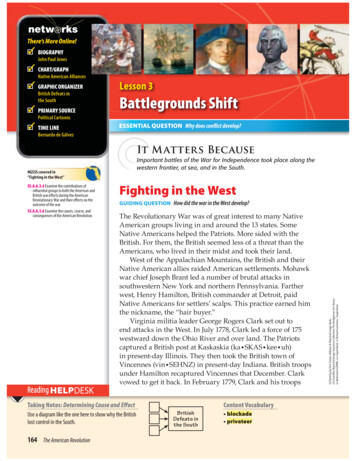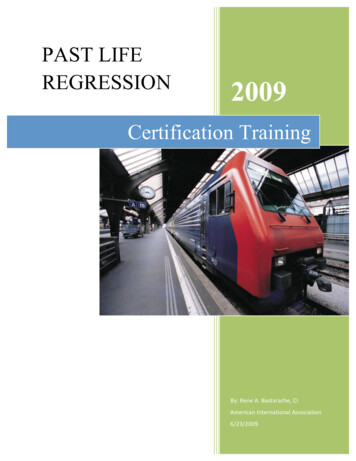
Transcription
netw rksThere’s More Online!BIOGRAPHYJohn Paul JonesCHART/GRAPHNative American AlliancesGRAPHIC ORGANIZERBritish Defeats inthe SouthPRIMARY SOURCELesson 3Battlegrounds ShiftPolitical CartoonsTIME LINEESSENTIAL QUESTION Why does conflict develop?Bernardo de GálvezIt M atters BecauseImportant battles of the War for Independence took place along thewestern frontier, at sea, and in the South.NGSSS covered in“Fighting in the West”Reading HELP DESKFighting in the WestGUIDING QUESTION How did the war in the West develop?The Revolutionary War was of great interest to many NativeAmerican groups living in and around the 13 states. SomeNative Americans helped the Patriots. More sided with theBritish. For them, the British seemed less of a threat than theAmericans, who lived in their midst and took their land.West of the Appalachian Mountains, the British and theirNative American allies raided American settlements. Mohawkwar chief Joseph Brant led a number of brutal attacks insouthwestern New York and northern Pennsylvania. Fartherwest, Henry Hamilton, British commander at Detroit, paidNative Americans for settlers’ scalps. This practice earned himthe nickname, the “hair buyer.”Virginia militia leader George Rogers Clark set out toend attacks in the West. In July 1778, Clark led a force of 175westward down the Ohio River and over land. The Patriotscaptured a British post at Kaskaskia (ka SKAS kee uh)in present-day Illinois. They then took the British town ofVincennes (vin SEHNZ) in present-day Indiana. British troopsunder Hamilton recaptured Vincennes that December. Clarkvowed to get it back. In February 1779, Clark and his troopsTaking Notes: Determining Cause and EffectUse a diagram like the one here to show why the Britishlost control in the South.164 The American RevolutionContent VocabularyBritishDefeats inthe South blockade privateer(l) Painting by Don Troiani, Military & Historical Image Bank,(cl) Guardian Royal Exchange Insurance Collection/The Bridgeman Art Library,(c) Bettmann/CORBIS, (cr) SuperStock, (r) Richard Cummins / SuperStockSS.8.A.3.4 Examine the contributions ofinfluential groups to both the American andBritish war efforts during the AmericanRevolutionary War and their effects on theoutcome of the war.SS.8.A.3.6 Examine the causes, course, andconsequences of the American Revolution.
braved harsh winter conditions to surprise the British and forcetheir surrender. Clark’s victory strengthened the Americanposition in the West. PROGRESS CHECKSummarizing What victories did the American forces win in the West?The War at SeaAt the time of the Revolution, about200,000 Native Americans lived alongthe western frontier. Here they attackan American settlement inPennsylvania’s Wyoming Valleyin 1778. CRITICAL THINKING SS.8.A.3.4Speculating Why do you think manyNative Americans supported the Britishrather than the Americans?GUIDING QUESTION What was the result of the war at sea?The Revolutionary War also took place at sea. Here GreatBritain’s powerful navy enjoyed a major advantage. Britishvessels formed an effective blockade (blo KAYD), keepingships from entering or leaving American harbors. The blockadelimited delivery of supplies and troops to Patriot forces.Painting by Don Troiani, Military & Historical Image BankPrivateersNGSSS covered in“The War at Sea”SS.8.A.3.4 Examine the contributions ofinfluential groups to both the American andBritish war efforts during the AmericanRevolutionary War and their effects on theoutcome of the war.SS.8.A.3.6 Examine the causes, course, andconsequences of the American Revolution.To break the blockade, Congress ordered 13 warships, but onlytwo of the ships made it to sea. Several were quickly captured bythe British. The American navy was too weak to operate well.Congress also authorized some 2,000 ships to sail asprivateers. A privateer (pry vuh TEER) is a privately ownedmerchant ship outfitted w
west, Henry Hamilton, British commander at Detroit, paid Native Americans for settlers' scalps. This practice earned him the nickname, the "hair buyer." Virginia militia leader George Rogers Clark set out to end attacks in the West. In July 1778, Clark led a force of 175 westward down the Ohio River and over land. The Patriots











